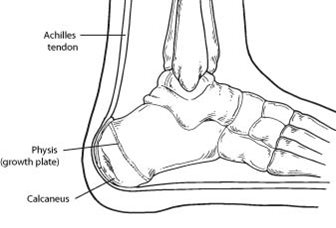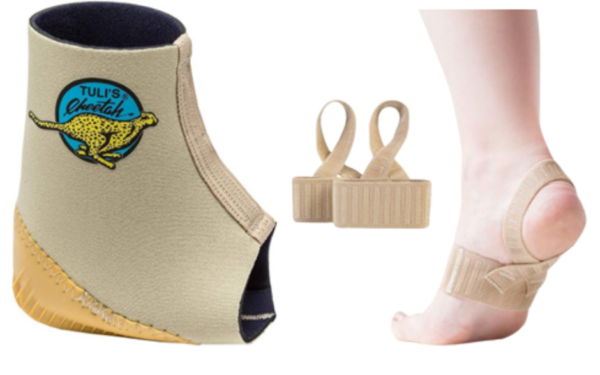
Podiatrist Dr. Tenaya West on what causes heel pain in gymnasts, and how you can manage it.
Calcaneal apophysitis, commonly known as Sever’s disease, is a prevalent cause of heel pain in young female gymnasts, typically around the age of 7-12 years old. The condition stems from inflammation in the growth plate of the calcaneus (heel bone), exacerbated by repetitive stress during periods of accelerated growth.

Photo credit: foothealthfacts.org
What are some risk factors for developing Sever’s?
- Age – This condition only occurs when the growth plate is open (typically around 7-12 years old).
- Limited ankle dorsiflexion: during periods of accelerated growth, the bones may grow more quickly than the soft tissue. A tight calf muscle can lead to high traction forces from the achilles, and shear stress of the growth plate.
- Biomechanics: Some foot types (flat foot or high arch) can be associated with Sever’s.
- Training: High impact and repetitive stresses can trigger or worsen this condition.
Is imaging needed?
Sever’s is diagnosed by symptoms and clinical exam. However, x-rays or other tests are sometimes ordered to rule out other causes for heel pain. Be sure to have the gymnast tell their doctor if there was a bad fall, or they have any additional symptoms such as a fever.
What can help?
- Calf stretching: Stretching both the gastrocnemius and soleus muscles is important when treating Sever’s. Working with an athletic trainer and/or physical therapist can also be helpful to form a comprehensive rehab program.
- Massage: try a foam roller on the calf, and a golf or lacrosse ball on the arch of the foot
- Ice: Ice at least twice a day. Try freezing water in a paper cup to do an “ice massage” of the heel.
- Heel cups or x-strap during practice: A wrap-on heel cup (ie Tuli cheetah heel cup) or X strap (ie Tuli the X brace) can be equally effective in helping symptoms in barefoot athletes (Sweeney et al, 2023).

A wrap-on heel cup (ie Tuli cheetah heel cup) or X strap (ie Tuli the X brace) can both be effective in helping symptoms in barefoot athletes
- Supportive shoes outside of practice: every step counts!
- When in the house (or at meets on cement), try a “recovery sandal” that has a built-in arch and cushioned heel.
- When at school, a supportive tennis shoe is best. To see if a shoe passes, try these three simple tests:
- Try to bend the shoe in half. It should only bend at the toes, not in the middle.
- Try to twist the shoe. You should not be able to wring it out like a dish towel!
- Squeeze the heel. The back of the shoe should be sturdy (no slip on sneakers, or soft fabric backs)
- Try adding an arch support in. Consider one from your local running store, where the brands will be higher quality than drugstore brands. In general, you are looking for one that is supportive over soft. Same rule as the shoes – you should only be able to fold it near the toes.
- Add a heel cup (ie Tuli heel cup)
- Cross training and rest: If symptoms are continuing despite the above, a cross training plan should be developed to rest the heels. The gymnast’s pediatrician, orthopedist, or podiatric physician should also be visited to rule out other causes for heel pain.
This is not a condition that a gymnast should have to “tough out” until their growth plates close. With consistent efforts at the above, symptoms can be well managed while maintaining a high level of training.
Dr. Tenaya West, DPM, FACFAS, is a podiatrist based in San Jose, CA.
References:
Nieto-Gil P, Marco-Lledo J, Garcia-Campos J et al. Risk factors and associated factors for calcaneal apophysitis (Sever’s disease): a systematic review. BMJ Open 2023; 13:e064903
Sweeney E, Little C, WIlson J, et al. Comparison of braces for treatment of Sever’s disease (calcaneal apophysitis) in barefoot athletes: a randomized clinical trial. Journal of Athletic Training 2023; 58(5): 437